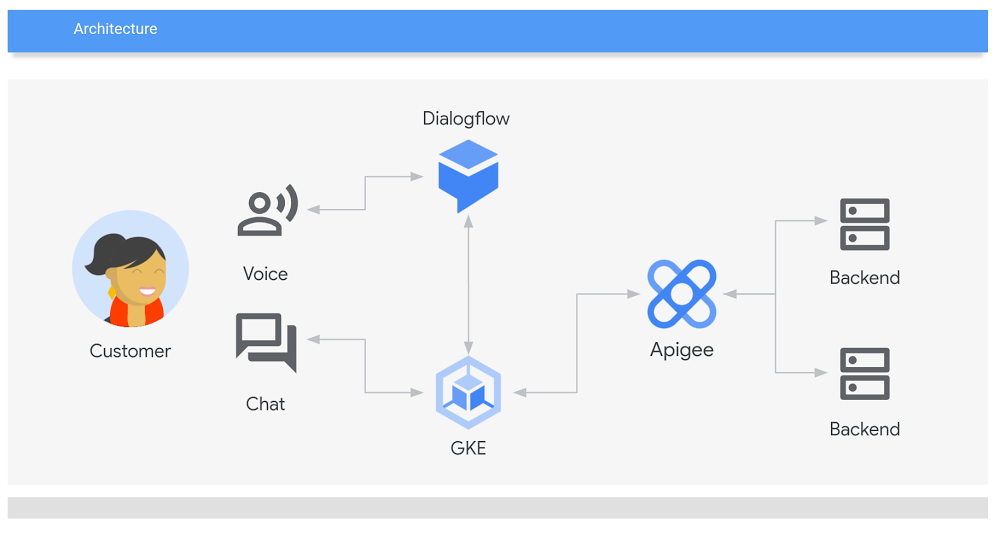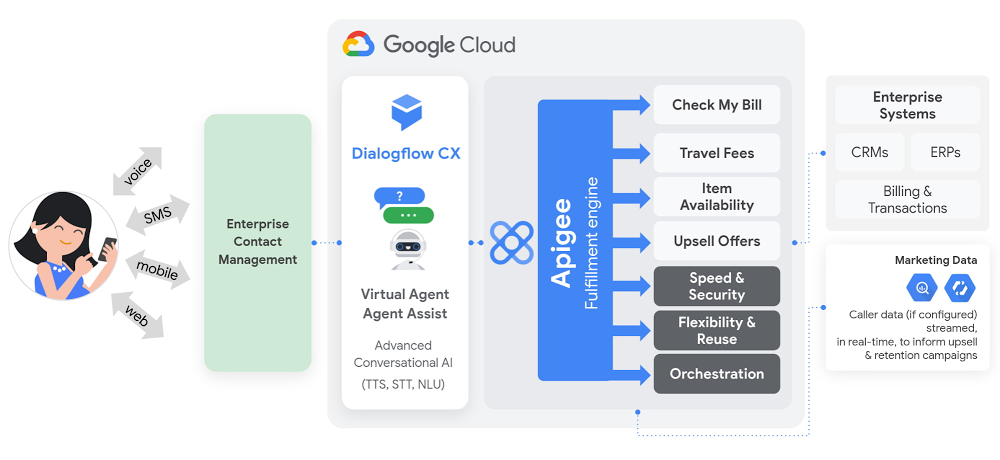GCP – Conversational AI with Apigee API Management for enhancing customer experiences
The pandemic has accelerated enterprises’ digital transformation investments, notably their efforts to use AI and the cloud to meet rising customer expectations.
This means, among other things, that virtual agents and other interactive bots should be part of an organization’s customer service toolset.To provide the excellent experiences that customers demand, it’s not an option for enterprises to continue to rely on live agents, which are hard to scale, or outdated contact management systems with rigidly scripted flows, which are as likely to frustrate customers as to answer their questions. In fact, Gartner predicts in its February 2020 article “Top CX Trends for CIOs to Watch” that by 2022, 70% of customer interactions will involve emerging technologies such as machine learning (ML) applications, chatbots and mobile messaging, up from 15% in 2018.
However, integrating virtual agents or bots with enterprise systems and processes can be difficult. Chat and voice bots or virtual agents rely on enterprise data, systems, and business functions, accessed via APIs and integration frameworks. To successfully facilitate this process, Google Cloud offers several solutions–such as Contact Center AI, Dialogflow and Apigee API management–that are helping enterprises to launch powerful virtual agents without being bogged down by system complexity.
The Woolworths Approach: Providing cutting-edge customer experiences with Apigee and Dialogflow
Woolworths, one of the largest retailers in Australia, demonstrates the power of conversational AI and API management, as it has leveraged these technologies to provide seamless customer experiences across a wide range of channels, from web and mobile apps to Google Home. These experiences include the virtual agent Olive, which was created by WooliesX (the company’s digital business unit) and uses both Dialogflow and Apigee to deliver services.
Apigee helps the company manage APIs across its business, which speeds up development of new digital experiences by giving Woolworths developers secure, simple, and consistent access to the data and functionality they need. Olive uses Dialogflow as its natural language platform, with APIs providing the information Olive needs to serve up useful customer interactions.
The result is that customers have a consistent experience across numerous Woolworths brands, such as Dan Murphy’s and BIG W–all accessible from a variety of digital platforms and assistants. In a Google Cloud Next presentation, Joshua Rogers, Platform Technology Manager at Woolies X, said this consistency and flexibility around customer preference “generate a bond with our customer” that serves long-term retention.
“We want customers to connect with Woolworths and our business units in a way that’s comfortable for them,” said Nick Eshkenazi, Chief Digital Technology Officer at Woolworths. “It could be through social media, or any smart home devices. So, we leveraged Google Cloud’s Dialogflow and Apigee API management solutions to build a new virtual agent called Olive. We’ve seen market-leading performance from Olive right from the start.”
Taking a closer look at how Woolworth built Olive, the chatbot sits atop digital applications and microservices, hosted within Google Kubernetes Engine (GKE), that call on other services and sources of data to complete the customer’s request. An API Gateway provided by Apigee, which also played a key role in the company’s cloud migration, facilitates this process. Data is then funneled back into applications in GKE, which prepares it for delivery to the customer, whether via Google Hangouts, a first-party text-based chatbot, Google Home devices, or a Hub’s IVR.
Apigee API Management and Dialogflow: How do they work together
Through APIs, virtual agents created with Dialogflow communicate with both customers and backend systems that contain the information or experiences that customers need. This process requires fast response time: roundtrip delay should be less than 150 milliseconds (ITU-T G.114 recommends a maximum of a 150 ms one-way latency). With multiple disparate backend systems and legacy applications involved, getting a response within this acceptable time window can be very challenging. Apigee provides this glue using its pre-warm cache capability to get a nearly instantaneous response.
Additionally, those call requests may require access to systems localized in multiple clouds and/or on-premises systems. Apigee fulfillment simplifies, orchestrates, and secures the interaction between those APIs and an enterprise’s business processes. And because Apigee acts as an abstraction layer, it makes it possible to monitor APIs, SLAs (service-level agreements), and SLOs (service-level objectives)—all capabilities that help organizations such as Woolworths to ensure they’re delivering fast, useful, seamless experiences to customers.
For many enterprises, connectivity between conversational AI solutions and backend systems is challenging and time consuming. However, with Dialogflow and Apigee, those challenges can be quickly surmounted, leaving enterprises enough time to focus on delivering delightful experiences to their end-consumers.
Try Dialogflow and Apigee for free and start unlocking new digital experiences for your customers.
Read More for the details.




